Table of Contents
Modern living brings endless distractions, from traffic rumble to loud neighbors. Unwanted sounds can disrupt relaxation, focus, and even sleep. The EPA links prolonged exposure to excessive noise with stress and health issues.
Creating a peaceful space isn’t just about luxury—it’s essential for well-being. Whether you live in a bustling city or a quiet suburb, soundproofing techniques can transform your environment.Why Noise Reduction Matters at Home
Unwanted sounds aren’t just annoying; they’re scientifically proven to harm well-being. The EPA links prolonged exposure to loud environments with a 31% increase in stress and 27% more sleep disruptions. Over time, this can escalate to cardiovascular issues.

Chronic noise triggers your brain’s fight-or-flight response, even during sleep. Studies show it elevates cortisol levels, impairing memory and focus. Urban areas average 60–70 decibels (dB)—equivalent to a constant vacuum cleaner.
Sound behaves differently based on materials. Thin drywall absorbs only 25% of waves, while dense insulation blocks up to 75%. This is measured by Sound Transmission Class (STC) ratings—higher numbers mean better barriers.
| Common Sounds | Decibel Level (dB) | Health Impact |
|---|---|---|
| Normal conversation | 60 | Safe |
| City traffic | 70–85 | Stress risk |
| Lawn mower | 90 | Hearing damage |
In Michigan, homes combining fiberglass insulation and acoustic panels saw a 40% drop in indoor noise. Simple solutions like sealing gaps or adding rugs make a measurable difference.
Your environment shouldn’t compromise your health. Understanding these impacts is the first step toward quieter, healthier living.
1. Seal the Gaps: Your First Defense Against Unwanted Sound
Small gaps in your home can let in more than drafts—they’re sound highways. Even a 0.5mm crack around a door can leak 8–12 decibels, equivalent to a whisper turning into a conversation. Start with these fixes to block sound at its entry points.
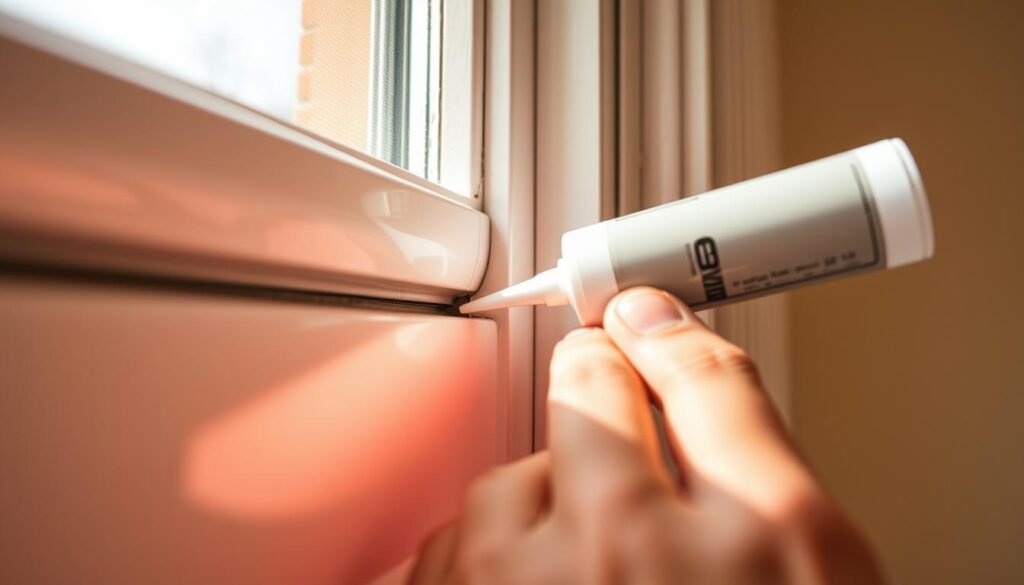
Weatherstripping Doors and Windows
Vinyl, silicone, and foam strips create airtight seals. Each material suits different budgets and durability needs:
| Material | Cost (per foot) | Lifespan | Best For |
|---|---|---|---|
| Vinyl | $0.50 | 5 years | High-traffic doors |
| Silicone | $1.20 | 10+ years | Extreme temperatures |
| Foam | $0.30 | 2 years | Temporary fixes |
Filling Wall Holes with Acoustic Caulk
Gaps around outlets or ducts weaken insulation. Acoustic caulk stays flexible, preventing cracks as walls shift. A Michigan study showed it cuts sound transmission by 30% when applied to electrical boxes.
Installing Door Sweeps for Tighter Seals
Brush sweeps suit uneven floors, while rubber ones block more sound. The Suptikes Soundproof Seal reduces noise by 12dB—like turning off a blender. DIY installation takes 10 minutes and costs under $20.
Sealing gaps is the fastest way to prevent sound leaks. Combine these methods for layered protection.
2. Soften Surfaces to Absorb Sound Waves
Hard surfaces bounce sound waves like a basketball, amplifying every footstep and conversation. The right fabrics and textures can turn echoes into whispers. Start with what’s underfoot—your floors are prime real estate for sound absorption.
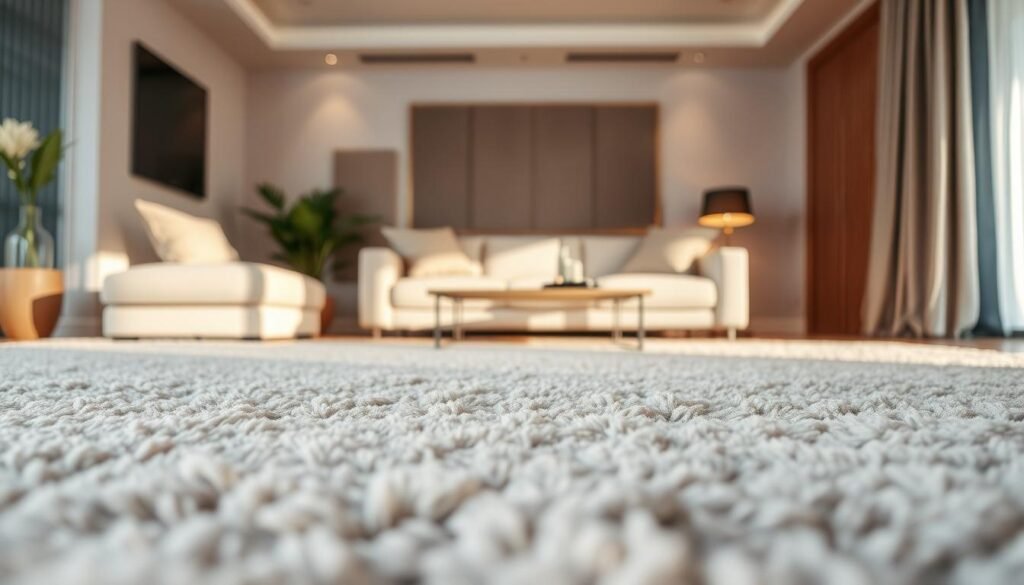
How Rugs and Carpets Dampen Noise
Thick rugs act like sponges for sound. A 10mm rug pad slams the brakes on impact noise, cutting it by 50%. Wool carpets outperform synthetics, absorbing 30% more sound due to their dense fibers.
| Material | Noise Reduction Coefficient (NRC)* | Best For |
|---|---|---|
| Wool carpet | 0.55 | Living rooms, bedrooms |
| Polyester rug | 0.35 | Low-traffic areas |
| Jute pad (underlay) | 0.40 | Enhancing thin rugs |
*NRC measures how well a material absorbs sound. Higher = better.
Choosing the Right Thickness
Density matters more than size. RugPadUSA’s Ultra Density line adds mass without bulk, ideal for apartments. Layer a jute pad under a Persian-style rug for a luxury feel with extra quiet.
Strategic Placement for High-Traffic Areas
Focus on zones where sound travels most: hallways, under dining tables, and beside beds. An IKEA RENS sheepskin rug hung on a wall absorbs mid-range frequencies—a quirky hack for renters.
Your floors don’t have to be noisy. With the right layers, they’ll absorb sound instead of spreading it.
3. Upgrade to Solid-Core Doors for Better Sound Barriers
Your front door might be the weakest link in your home’s sound defense system. Hollow-core doors—common in many homes—are essentially soundproofing failures, with thin veneers over empty space. Replacing them with solid-core materials can transform noise levels instantly.
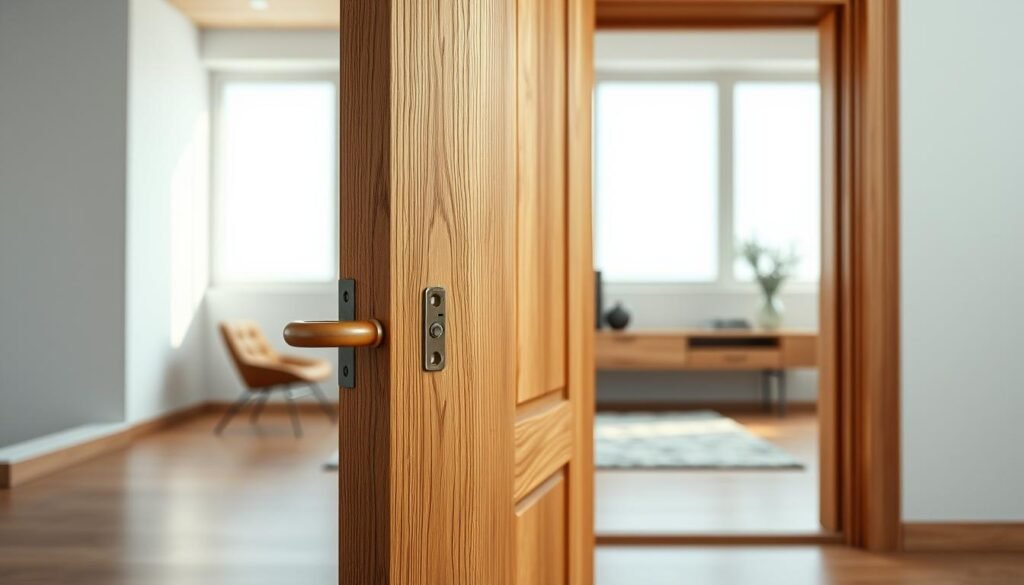
Hollow vs. Solid: A Decibel Showdown
Standard hollow-core doors block only 18–22dB, while solid wood or composite cores provide better 25–32dB reduction. That’s the difference between hearing a TV blare and catching muffled whispers.
| Door Type | Noise Reduction (dB) | Best For |
|---|---|---|
| Hollow-core | 18–22 | Closets, low-traffic areas |
| Solid-core wood | 25–32 | Bedrooms, home offices |
Budget-Friendly Upgrades
Home Depot’s Masonite solid-core doors start at $189, while Lowe’s Jeld-Wen models ($249) offer tighter seals. For renters, temporary fixes like adhesive MLV sheets cut noise by 6–8dB without permanent changes.
Boosting Insulation with Mass-Loaded Vinyl
Layer MLV with Green Glue compound for a 70% noise drop. Fire-Rated Doors Inc. customizes options with wood veneers, but check your frame’s weight limit—some can’t handle 80+ lb doors.
Pro tip: A $300 solid-core door pays for itself in barrier performance, rivaling expensive wall modifications.
4. How to Reduce Noise at Home with Acoustic Panels
From home studios to busy living rooms, acoustic panels offer a sleek solution for sound control. These textured surfaces trap and dissipate echoes, cutting reverberation by 0.8–1.2 seconds (ADW Acoustics). Unlike bulky foam, modern designs blend seamlessly with decor while tackling noise.
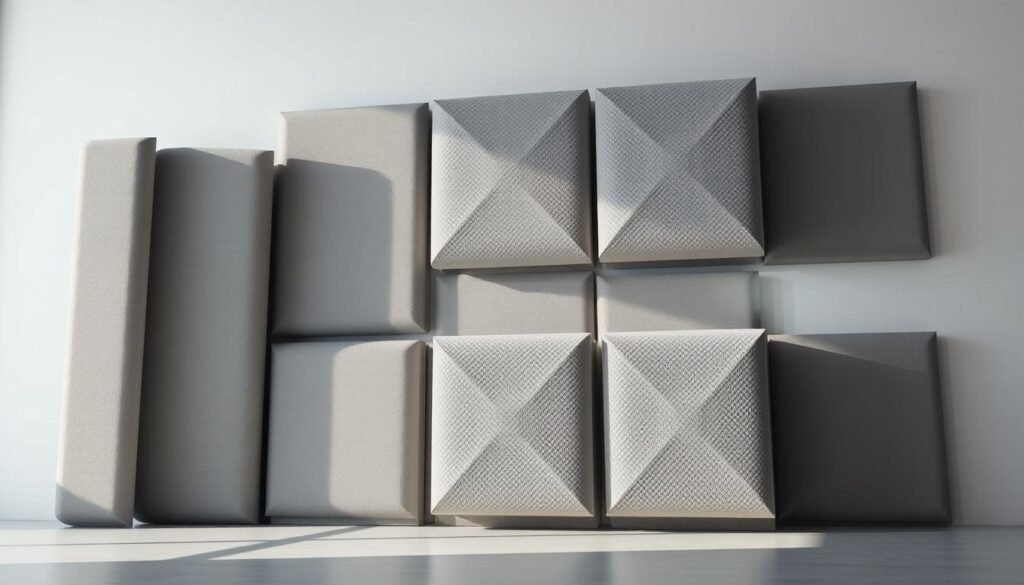
DIY vs. Professional Installation
Felt panels cost $12/sqft for DIY kits—ideal for renters. For permanent setups, pro-grade options like ATS Acoustics outperform with thicker cores. Compare key specs:
| Brand | Noise Reduction (NRC) | Thickness | Price/sqft |
|---|---|---|---|
| ATS Acoustics | 1.0 | 2″ | $18 |
| GIK Acoustics | 0.9 | 1.5″ | $15 |
| DIY Felt | 0.7 | 1″ | $12 |
Creative Placement Beyond Walls
Ceiling-mounted panels work wonders in home theaters. Try angled 3D-printed brackets to deflect sound toward absorption zones. Even bookshelves can double as barriers when lined with thin panels.
“Covering 30–50% of wall surface optimizes sound absorption without overcrowding.”
Matching Panels to Your Decor
Joybird’s upholstered acoustic panels mimic mid-century furniture. For minimalist spaces, try Fabricmate’s customizable prints. Pro tip: Layer panels behind artwork for invisible sound absorption.
Whether DIY or pro-installed, these solutions turn chaos into calm. Start with high-traffic areas and expand as needed.
5. Create a White Noise Buffer Zone
White noise acts like an acoustic shield, blending disruptive sounds into the background. Homedics machines cover a 35–85dB range, effectively masking everything from chatter to traffic. This technique doesn’t eliminate noise—it reprograms your environment to feel quieter.
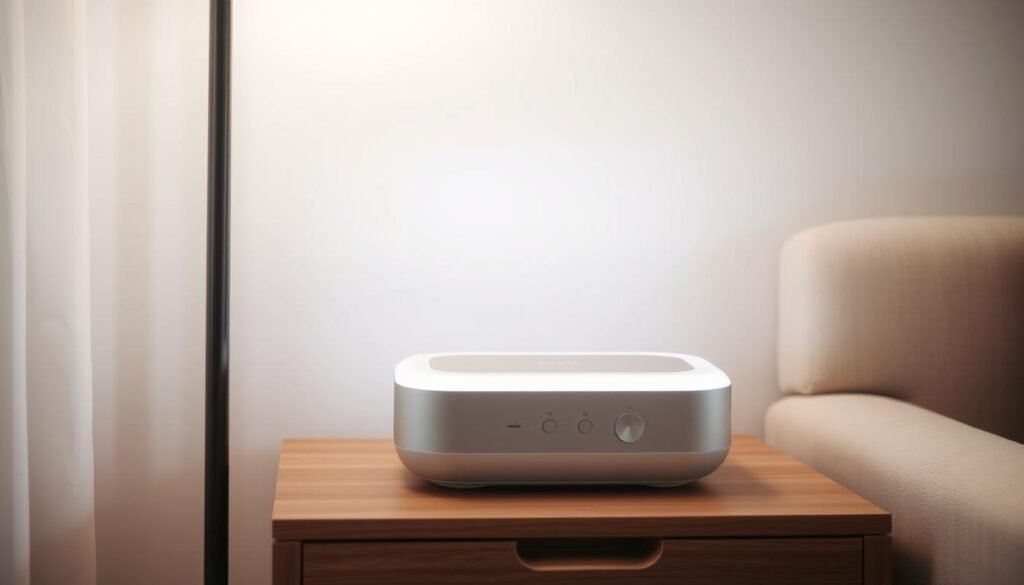
Finding the Right White Noise Machine
Not all devices are equal. Compare frequency ranges and features:
| Model | Price | Key Feature |
|---|---|---|
| LectroFan | $60 | 20 fan & white noise sounds |
| Marpac Dohm | $50 | Mechanical fan-based sound |
Bose Sleepbuds II offer personalized soundscapes, ideal for light sleepers.
Natural Alternatives: Water Features
Indoor fountains reduce perceived noise by 40%. SmartRock pumps are whisper-quiet, perfect for small spaces. The trickle of water masks unwanted sounds without electronics.
Calibrating Volume for Maximum Effect
Follow Fletcher-Munson curves: 50–60dB is optimal. Too loud, and it’s distracting; too soft, and it’s ineffective. Test levels by playing a machine while someone talks nearby—words should blur but not disappear.
“White noise works best when it’s slightly louder than the disturbance you’re masking.”
A white noise machine isn’t just for sleep. Use it in home offices or nurseries to create consistent acoustic comfort.
6. Rearrange Your Space for Sound Isolation
Bookcases do more than hold books—they’re powerful sound barriers. A fully loaded IKEA BILLY unit blocks 12-15dB, equivalent to turning down a blender. Smart furniture placement can significantly reduce echoes without renovations.
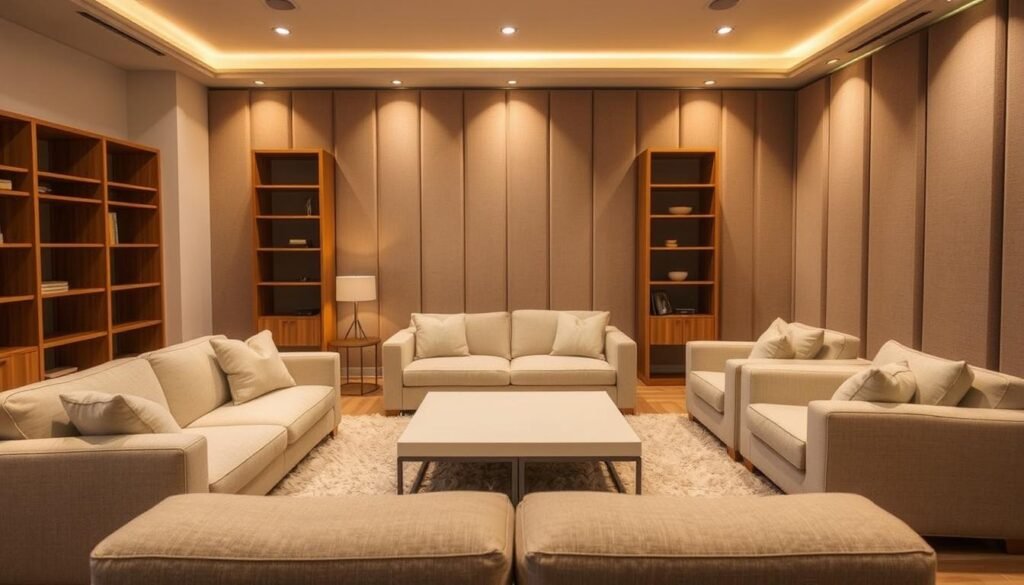
Furniture Placement Strategies
Angling sofas or shelves at 45° breaks up sound waves. West Elm’s modular room dividers create zig-zag patterns that diffuse noise. Key zones to address:
- Place heavy furniture against shared walls
- Leave 4-6″ gaps behind pieces for air absorption
- Use upholstered items as natural buffers
Using Bookcases as Sound Barriers
Density matters more than height. Compare popular options:
| Bookcase Model | Depth | Noise Reduction |
|---|---|---|
| IKEA BILLY | 11″ | 12-15dB |
| Wayfair Solid Wood | 14″ | 18dB |
Fill shelves 70-80% for optimal absorption—books work better than decor items.
Creating Quiet Zones in Open Floor Plans
Wayfair’s acoustic dividers section off space without permanent walls. For high-tech solutions, Sonos speakers can project sound bubbles around workspaces. Map trouble spots by noting where voices carry most.
“Open layouts need layered approaches—combine physical barriers with sound masking.”
With these tweaks, you’ll create peaceful areas even in bustling homes. Start with one problem zone and expand your barrier system gradually.
7. Invest in Window Upgrades for External Noise Control
Windows are often the weakest barrier against street clamor, leaking up to 70% of external sounds. The right upgrades can turn them into soundproofing powerhouses—without a full renovation.
Double-Pane vs. Triple-Pane Showdown
Pella’s 350 Series triple-pane windows slash noise by 42dB—like swapping a jackhammer for a whisper. Compare top brands:
| Brand | STC Rating* | Noise Reduction |
|---|---|---|
| Andersen 400 | 35 | 38dB |
| Marvin Ultimate | 37 | 40dB |
*Sound Transmission Class: Higher = better.
Temporary Fixes for Renters
Indow acrylic inserts cut noise by 50% for $200/window. Duck Brand shrink film kits offer a $15 solution—just heat-seal over existing glass. Both add insulation without permanent changes.
Layered Defense: Curtains + Inserts
Nicetown’s blackout curtains (with sewn-in magnets) block 60% of noise when paired with inserts. A Chicago high-rise project combined these with weatherstripping, dropping indoor decibels by 30%.
“Layering treatments multiplies their effect—like wearing earplugs under noise-canceling headphones.”
- Energy bonus: Upgrades save 15–20% on HVAC bills.
- Pro tip: Install during warmer months for easier sealing.
Whether you opt for premium glass or DIY hacks, these materials create quieter spaces by tackling sound at its source.